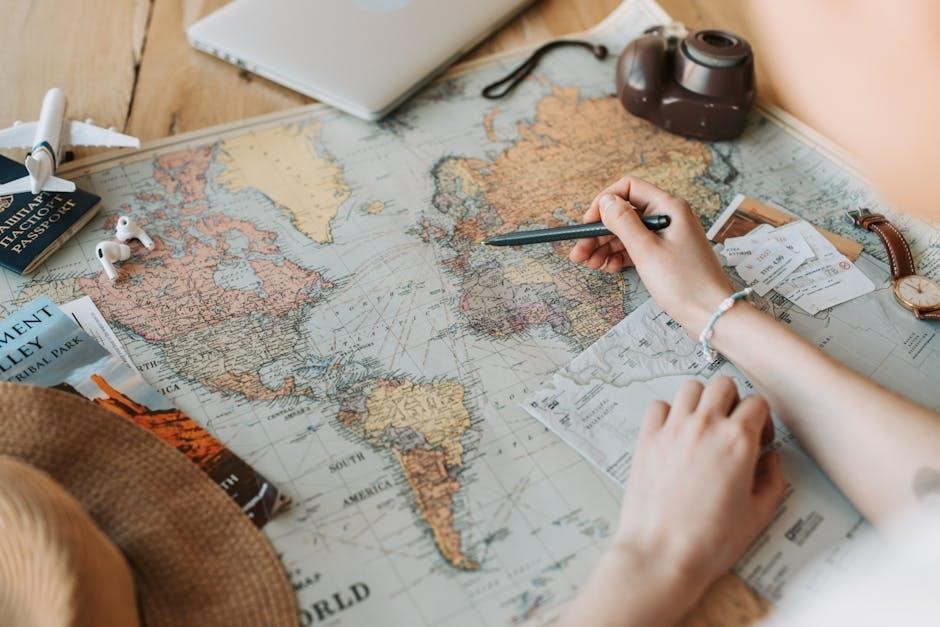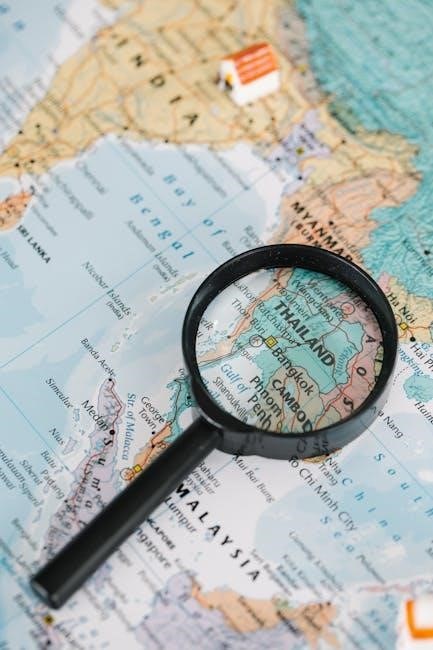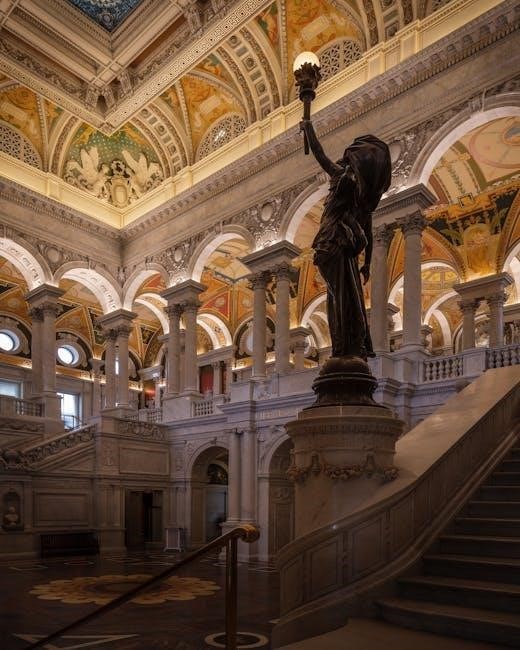AP World History Unit 4 Study Guide covers transoceanic interconnections from 1450 to 1750, utilizing online resources like Quizlet for flashcards and study guides to facilitate learning and understanding of historical developments.
Overview of the Unit
The AP World History Unit 4 study guide provides a comprehensive overview of the unit, covering the time period from 1450 to 1750. This unit focuses on transoceanic interconnections, exploring the interactions and exchanges between different cultures and civilizations. The unit is divided into several topics, including technological innovations, cross-cultural interactions, and patterns of trade and travel. Students can utilize online resources, such as Quizlet, to access study guides and flashcards that facilitate learning and understanding of the unit’s key concepts. The unit’s overview is essential for students to understand the broader context of the period, including the major events, trends, and developments that shaped the world during this time. By studying this unit, students can gain a deeper understanding of the complex and interconnected nature of world history, and how different cultures and civilizations have influenced each other over time.
Importance of Studying Unit 4
Studying Unit 4 of the AP World History course is crucial for understanding the complexities of global interactions and exchanges. This unit provides a foundation for analyzing the impact of historical events on modern society. By examining the transoceanic interconnections of the past, students can develop a deeper understanding of the cultural, economic, and political dynamics that shape the world today. The skills and knowledge gained from studying Unit 4 can be applied to a wide range of fields, including international relations, economics, and cultural studies. Furthermore, the unit’s focus on critical thinking and analysis helps students develop essential skills for success in academic and professional pursuits. Overall, studying Unit 4 is essential for anyone interested in understanding the intricacies of global history and its relevance to contemporary issues and challenges, and for developing a nuanced perspective on the world and its many cultures.

Transoceanic Interconnections
Transoceanic interconnections involve global trade and cultural exchange between nations and civilizations across oceans and continents from 1450 to 1750 using various online study guides and resources.
Technological Innovations from 1450-1750
During this period, various technological innovations emerged, significantly impacting global trade and cultural exchange. The development of new maritime technologies, such as the astrolabe and compass, enabled more efficient and accurate navigation. Additionally, advancements in shipbuilding and design, like the fluyt and galleon, increased cargo capacity and sailing speed. These innovations facilitated the growth of transoceanic trade, connecting distant regions and civilizations. The internet provides numerous resources, including online study guides and flashcards, to help students learn about these technological advancements and their effects on global interconnections. By utilizing these resources, students can gain a deeper understanding of the complex relationships between technological innovation, trade, and cultural exchange during this time period, ultimately preparing them for the AP World History exam. Overall, technological innovations played a crucial role in shaping the course of global history from 1450 to 1750.
Cross-Cultural Interactions and Diffusion of Technology
Cross-cultural interactions played a significant role in the diffusion of technology during this period. As different civilizations came into contact with one another, they exchanged ideas, goods, and technologies, leading to a widespread dissemination of innovations. The internet offers various study resources, including flashcards and study guides, to help students understand the complex processes of cross-cultural interaction and technological diffusion. These resources provide valuable insights into the ways in which different cultures adapted and modified technologies to suit their own needs, leading to a rich diversity of technological developments. By examining these interactions, students can gain a deeper understanding of the global dynamics that shaped the course of history from 1450 to 1750. Online resources, such as Quizlet, can also help students to identify key examples of cross-cultural interactions and technological diffusion, preparing them for the AP World History exam.

Patterns of Trade and Travel
Global commerce expanded from 1450 to 1750 with maritime exploration and trade routes.
Changes in Global Commerce from 1450 to 1750
Global commerce underwent significant changes from 1450 to 1750, with the establishment of new trade routes and the expansion of existing ones. The Age of Exploration played a crucial role in this process, as European powers such as Portugal and Spain sent ships around the world to establish trade connections. The discovery of new trade routes, such as the Cape of Good Hope, facilitated the exchange of goods between Europe, Asia, and the Americas. This led to an increase in global trade, with the exchange of goods such as spices, textiles, and precious metals. The growth of global commerce also led to the emergence of new economic systems, including capitalism and mercantilism. Overall, the changes in global commerce from 1450 to 1750 had a profound impact on the development of the modern global economy. Online resources like Quizlet provide study guides and flashcards to help students understand these changes.
Impact of Maritime Exploration on Global Trade
The impact of maritime exploration on global trade was significant, as it led to the establishment of new trade routes and the expansion of existing ones. European explorers, such as Columbus and Vasco da Gama, played a crucial role in this process, discovering new sea routes and establishing trade connections with Asia and the Americas. The use of maritime trade routes allowed for the transportation of goods over long distances, facilitating the exchange of commodities such as spices, textiles, and precious metals. This led to an increase in global trade, with European powers such as Portugal, Spain, and the Netherlands emerging as major trading nations. The impact of maritime exploration on global trade can be studied using online resources, including flashcards and study guides, which provide a comprehensive overview of the topic and its significance in AP World History Unit 4. These resources are essential for understanding the complexities of global trade during this period.

Historical Developments and Scientific Learning
Classical, Islamic, and European knowledge facilitated technological innovations and scientific learning from 1450 to 1750, shaping global interconnections and trade patterns significantly online.
Classical, Islamic, and European Contributions to Technology
The contributions of classical, Islamic, and European civilizations played a significant role in shaping technological advancements from 1450 to 1750.
These civilizations developed and disseminated various technologies, including the astrolabe, compass, and printing press, which facilitated global communication and trade.
Online resources, such as study guides and flashcards, can help students understand the impact of these technological innovations on global interconnections and the diffusion of knowledge across different regions and cultures, ultimately transforming the world.
Role of Knowledge and Scientific Learning in Shaping Global Interconnections
The role of knowledge and scientific learning was crucial in shaping global interconnections from 1450 to 1750, as it facilitated the exchange of ideas and innovations across different regions and cultures.
Through the dissemination of knowledge, various civilizations were able to adopt and adapt new technologies, leading to significant advancements in fields such as navigation, astronomy, and medicine.
Online study guides and resources, such as flashcards and review materials, can help students understand the complex relationships between knowledge, scientific learning, and global interconnections, and how these factors contributed to the transformation of the world during this period, ultimately leading to a more interconnected and interdependent global community.

Study Resources and Flashcards
Utilizing Quizlet and online study guides provides essential resources for AP World History Unit 4 review and preparation with interactive flashcards and practice tests available online.
Utilizing Quizlet and Other Study Tools for Unit 4
Quizlet is a valuable resource for AP World History Unit 4 study, offering a range of interactive study tools and games to help students learn and retain key terms and concepts. The website provides flashcards, tests, and study guides, all of which can be accessed online or through the Quizlet app. Additionally, students can create their own study sets and share them with classmates, making it a collaborative and social learning experience. Other study tools, such as online practice tests and review guides, can also be found on the Quizlet website, providing students with a comprehensive suite of resources to aid in their study of Unit 4. By utilizing these study tools, students can develop a deeper understanding of the material and improve their performance on the AP exam. Overall, Quizlet and other study tools are essential for success in AP World History Unit 4.

